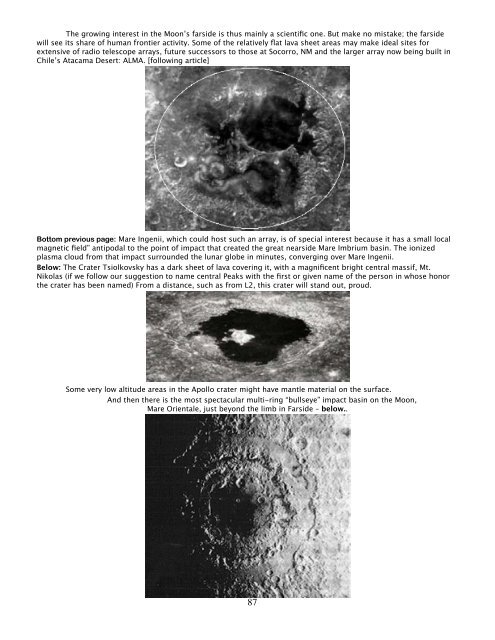Space Transportation - mmmt_transportation.pdf - Moon Society
Space Transportation - mmmt_transportation.pdf - Moon Society
Space Transportation - mmmt_transportation.pdf - Moon Society
You also want an ePaper? Increase the reach of your titles
YUMPU automatically turns print PDFs into web optimized ePapers that Google loves.
The growing interest in the <strong>Moon</strong>’s farside is thus mainly a scientific one. But make no mistake; the farside<br />
will see its share of human frontier activity. Some of the relatively flat lava sheet areas may make ideal sites for<br />
extensive of radio telescope arrays, future successors to those at Socorro, NM and the larger array now being built in<br />
Chile’s Atacama Desert: ALMA. [following article]<br />
Bottom previous page: Mare Ingenii, which could host such an array, is of special interest because it has a small local<br />
magnetic field” antipodal to the point of impact that created the great nearside Mare Imbrium basin. The ionized<br />
plasma cloud from that impact surrounded the lunar globe in minutes, converging over Mare Ingenii.<br />
Below: The Crater Tsiolkovsky has a dark sheet of lava covering it, with a magnificent bright central massif, Mt.<br />
Nikolas (if we follow our suggestion to name central Peaks with the first or given name of the person in whose honor<br />
the crater has been named) From a distance, such as from L2, this crater will stand out, proud.<br />
Some very low altitude areas in the Apollo crater might have mantle material on the surface.<br />
And then there is the most spectacular multi-ring “bullseye” impact basin on the <strong>Moon</strong>,<br />
Mare Orientale, just beyond the limb in Farside – below..<br />
87















